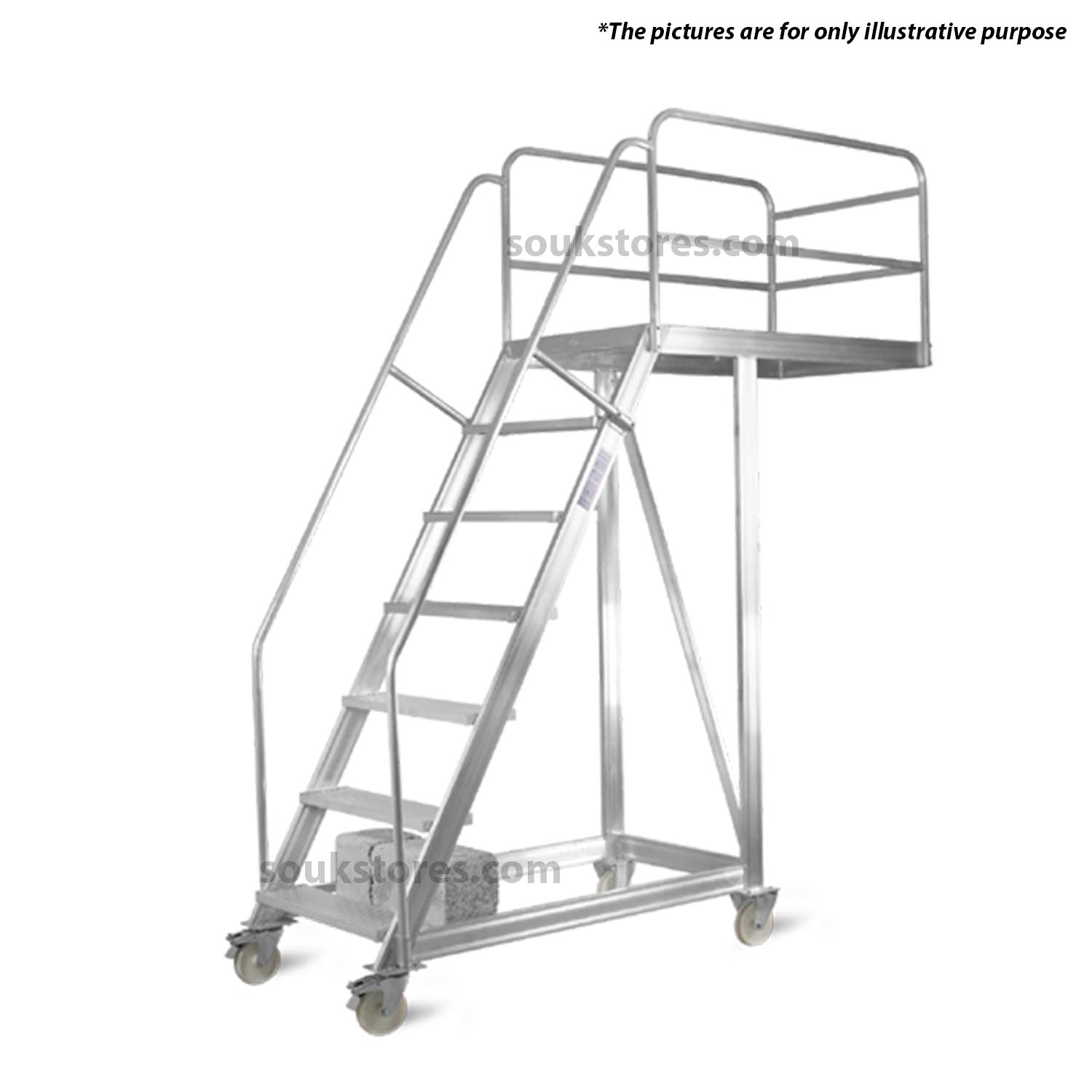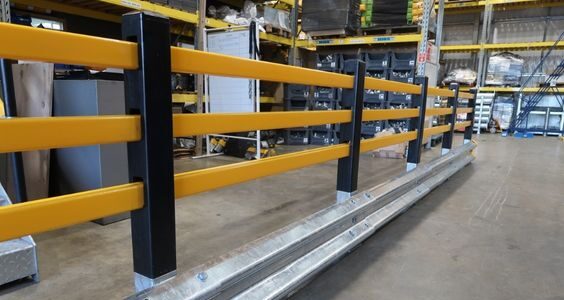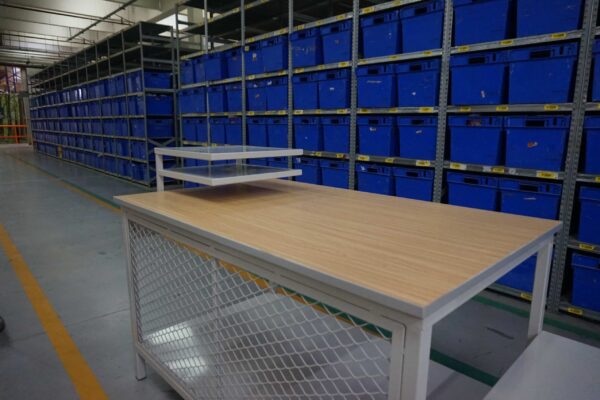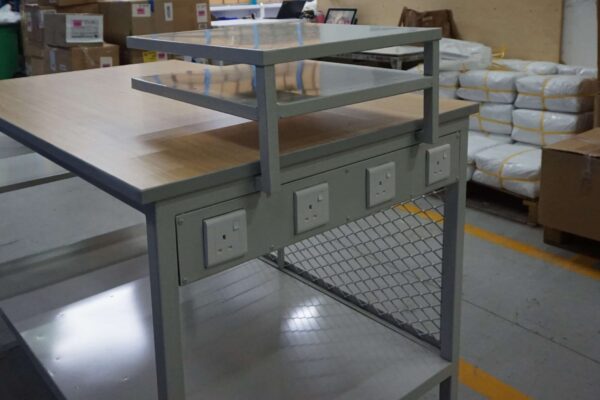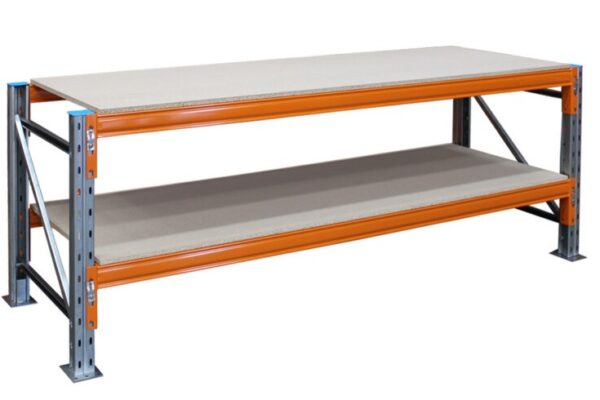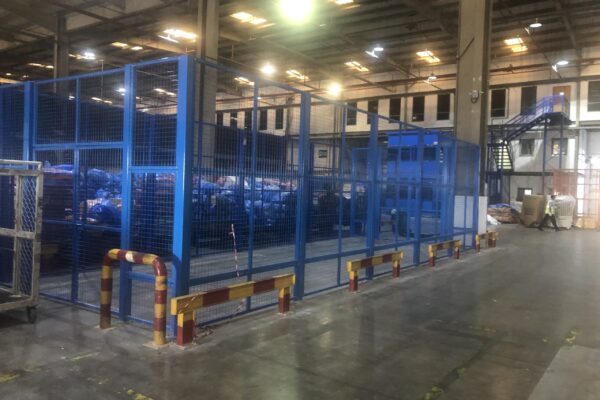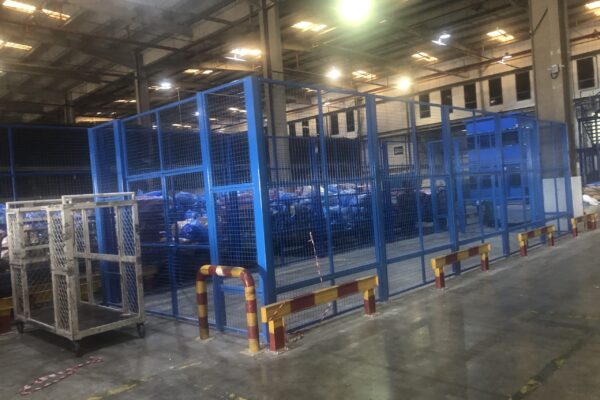


Pedestrian Barriers
These barriers create designated walkways for pedestrians, separating them from forklift traffic and other moving equipment, reducing the risk of collisions.
Forklift cages
Forklift cages, also known as forklift safety cages or forklift man baskets, are specialized attachments designed to be lifted by forklifts. They are commonly used in warehouses and industrial settings to elevate workers to perform various tasks at heights safely. Some of the common uses of forklift cages in warehouses include:
- Maintenance and repairs: Forklift cages allow maintenance personnel to access elevated areas, such as high shelves or overhead equipment, to inspect, repair, or replace components without the need for ladders or scaffolding.
- Stock picking: In large warehouses with high shelving units, forklift cages enable workers to pick items from elevated storage locations safely and efficiently.
- Inventory management: Workers can use forklift cages to perform stocktaking, inventory checks, and organize merchandise at elevated levels.
- Cleaning and maintenance of high areas: Forklift cages make it easier to clean and maintain hard-to-reach places like ceilings, lights, and ventilation systems.
- Warehouse organization: Workers can use forklift cages to rearrange items or materials stored at elevated levels to optimize storage space.
- Installation of equipment: When installing machinery or equipment at elevated locations, forklift cages provide a secure platform for workers to work from.
Operation Tables
Operation tables are typically made of durable materials like steel, aluminum, or robust plastics to withstand the demands of a warehouse environment and support heavy loads.The features of an operation table used in a warehouse are designed to enhance productivity, efficiency, and safety during various warehouse tasks. While specific features can vary based on the type of warehouse and its operations, here are some common features you might find in an operation table:
- Sturdy Construction:Operation tables are typically made of durable materials like steel, aluminum, or robust plastics to withstand the demands of a warehouse environment and support heavy loads.
- Work Surface: The table’s work surface is usually flat and smooth, providing a stable area for workers to perform tasks such as packing, sorting, and assembling items.
- Adjustable Height:Some operation tables offer height adjustability, allowing workers to set the table at an ergonomic height suitable for their comfort and to prevent strain or injury during extended periods of use.
- Storage Shelves and Drawers:Many operation tables come with integrated shelves, drawers, or storage compartments, enabling workers to keep tools, packing materials, and other supplies close at hand for quick access.
- Organization and Tool Holders:Built-in tool holders, racks, or pegboards help keep frequently used tools and equipment organized and within reach, reducing the time spent searching for items.
- Casters or Wheels:Some operation tables feature casters or wheels, making it easy to move the table within the warehouse for flexible workspace arrangements or to clear floor space when needed.
- Anti-Slip Surface:A non-slip surface on the table helps prevent items from sliding or shifting during tasks, ensuring stability and safety during various operations.
- Integrated Scales:For accurate weight measurements during packing or shipping, some operation tables may have integrated weighing scales or space to place standalone scales.
- Electrical Outlets and Ports: In certain setups, operation tables may include electrical outlets or ports for powering tools, computers, or other electronic devices used in the warehouse.
- Ergonomic Design:The table’s design takes into account ergonomic principles, such as rounded edges and adjustable components, to reduce strain and fatigue for workers.
- Modularity and Customization:Some operation tables are modular, allowing warehouse managers to configure and adapt them to fit specific tasks or workflows, creating a flexible and tailored workspace.
- Safety Features:Depending on the tasks performed, safety features like rounded edges, safety guards, or locking mechanisms might be incorporated into the design to protect workers and prevent accidents.
- Easy to Clean:The materials and design of operation tables should facilitate easy cleaning and maintenance to meet hygiene standards and keep the workspace tidy.
- Label Holders:Clear label holders on the table’s surface or storage areas help identify the contents of shelves or drawers, promoting organization and efficiency.
- Built-in Lighting: In warehouses with inadequate lighting, some operation tables may have integrated task lighting to improve visibility and reduce eye strain.
The specific features of an operation table will depend on the warehouse’s specific needs and the tasks performed at the table. Warehouse managers should carefully consider these features when selecting operation tables to ensure they meet the requirements of their operations and contribute to a smooth and efficient workflow.
Workbench
A workbench used in a warehouse is a versatile piece of furniture designed to provide a sturdy and organized workspace for various tasks. These workbenches are typically made of durable materials like steel, wood, or a combination of both. Here are some common features found in workbenches used in warehouses:
- Size and Dimensions: Warehouse workbenches come in various sizes to accommodate different tasks and available space. They can range from small, compact benches for specific tasks to large, expansive workbenches for more significant projects.
- Construction Materials: Workbenches are often constructed with materials like heavy-duty steel, solid wood, or composite materials to ensure durability and longevity, even in demanding warehouse environments.
- Weight Capacity: A crucial feature of warehouse workbenches is their weight capacity. They are designed to handle heavy loads, making them suitable for handling large items or equipment during repairs or assembly tasks.
- Adjustable Height: Some workbenches feature adjustable height options, allowing workers to customize the bench’s height based on their preferences and the nature of the task at hand. This ergonomic feature helps reduce strain and discomfort during extended working periods.
- Surface Material: The workbench’s surface is often made of materials like plywood, particleboard, or steel. Some surfaces have additional features like a non-slip coating to prevent items from sliding around during work.
- Storage Options: Workbenches may include various storage options such as drawers, shelves, cabinets, or pegboards. These storage solutions help workers keep tools, equipment, and supplies within easy reach, promoting a more organized and efficient workspace.
- Power Outlets and Lighting: Advanced workbenches may have built-in power outlets or USB ports, making it convenient for workers to plug in tools and electronic devices. Additionally, some workbenches may have integrated lighting to ensure proper visibility while working.
- Mobility: Depending on the warehouse layout and tasks performed, some workbenches may come with wheels or casters, allowing for easy mobility and flexibility within the workspace.
- Modularity: Modular workbenches offer the advantage of being customizable and reconfigurable. Workers can add accessories, change the layout, or expand the workbench as needed to adapt to changing requirements.
- Tool Rails and Organizers: Many warehouse workbenches have integrated tool rails, hooks, and organizers to keep essential tools and equipment within easy reach and well-organized.
- Anti-Corrosive Coating: For workbenches used in environments with exposure to moisture or chemicals, an anti-corrosive coating on metal parts is essential to prevent rust and maintain longevity.
Security cages or fences
Security cages or fences used in warehouses are essential for protecting valuable items, restricting access to authorized personnel, and maintaining a safe working environment. The features of these security cages or fences can vary depending on the specific requirements of the warehouse, but some common features include:
- Material: Security cages or fences are typically made from durable materials such as steel, aluminum, or heavy-duty wire mesh. These materials provide strength and resistance to tampering or forced entry.
- Height and Size: The height and size of the security cage or fence can be customized to fit the specific area of the warehouse that needs protection. They can be tall enough to prevent climbing over and wide enough to enclose the desired space.
- Locking Mechanisms: Security cages or fences often come with various locking mechanisms, such as padlocks, combination locks, or electronic access systems. These locks can be used to restrict access to authorized personnel only.
- Swing or Sliding Doors: Security cages may have either swing doors or sliding doors for entry and exit. Sliding doors are a space-saving option in areas with limited room for swinging doors.
- Mesh Design: If the cage uses wire mesh, the size of the mesh openings can be chosen to balance security and visibility. Smaller mesh openings offer higher security but may reduce visibility, while larger openings improve visibility but might be less secure.
- Surveillance and Monitoring: Some security cages may have provisions for installing surveillance cameras or monitoring systems to keep an eye on the enclosed area.
- Perimeter Lighting: Adding exterior lighting around the security cage can enhance visibility and deter potential intruders.
- Fire Safety Compliance: Depending on the warehouse’s regulations and requirements, security cages may need to adhere to fire safety standards, allowing for proper sprinkler systems and fire exits.
- Fire Safety Compliance: Depending on the warehouse’s regulations and requirements, security cages may need to adhere to fire safety standards, allowing for proper sprinkler systems and fire exits.
- Modular and Expandable: Many security cage systems are modular and can be expanded or reconfigured as the warehouse’s needs change over time.
- Compliance with Regulations: The security cage should comply with relevant safety and security regulations and standards, ensuring the protection of both people and goods.
- Warning Signs: Clear and visible warning signs indicating restricted access or stating the presence of security measures can deter unauthorized personnel from attempting to breach the cage.
- Customization: Security cages can be tailored to the specific needs of the warehouse, including custom sizes, colors, and configurations.


